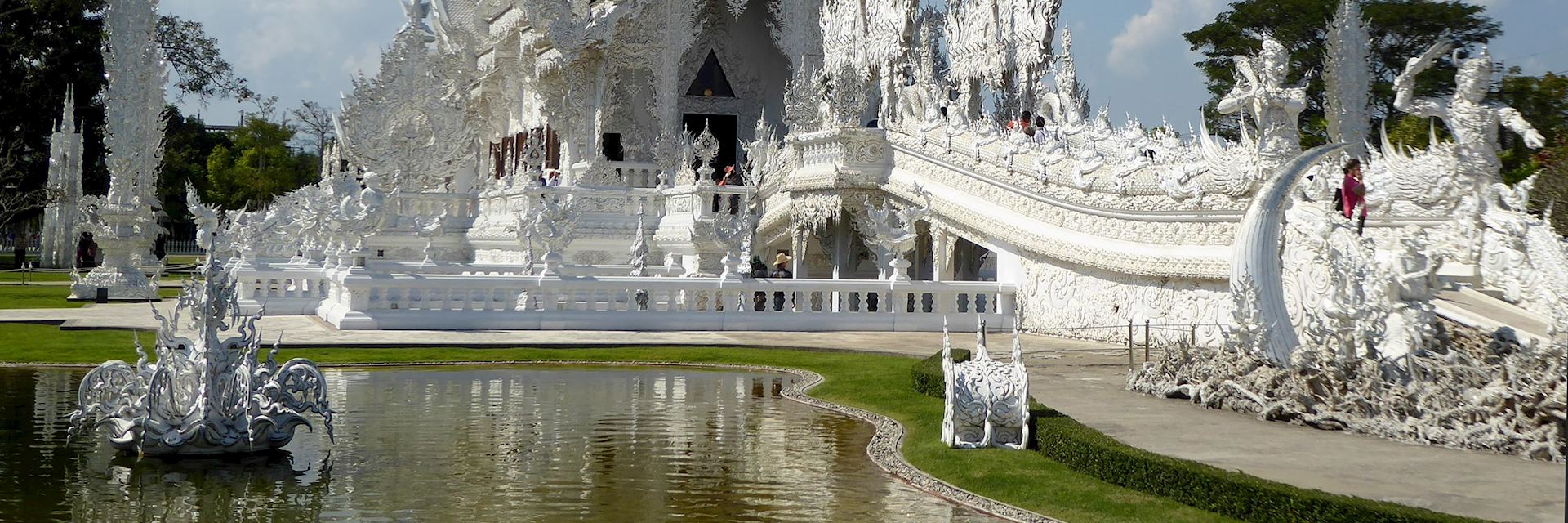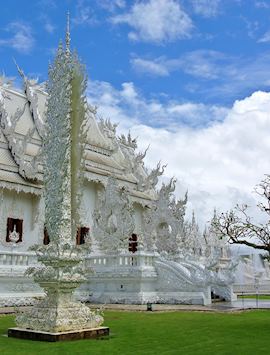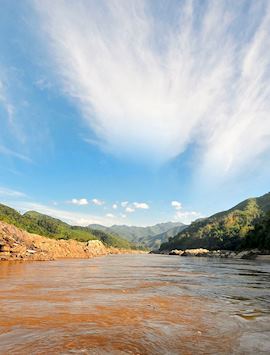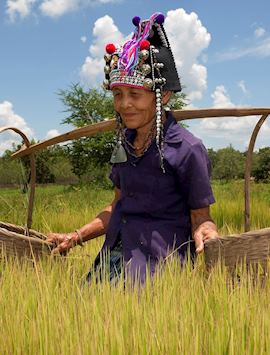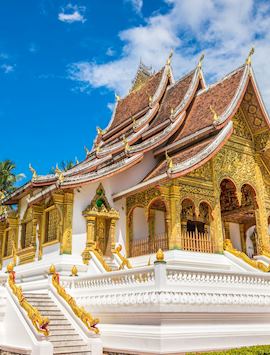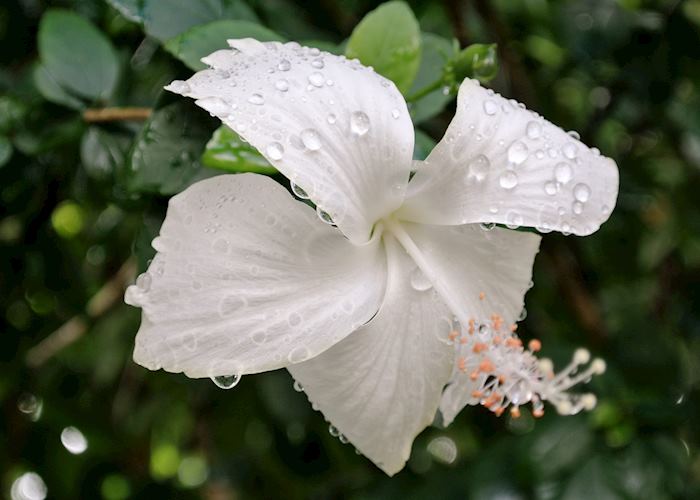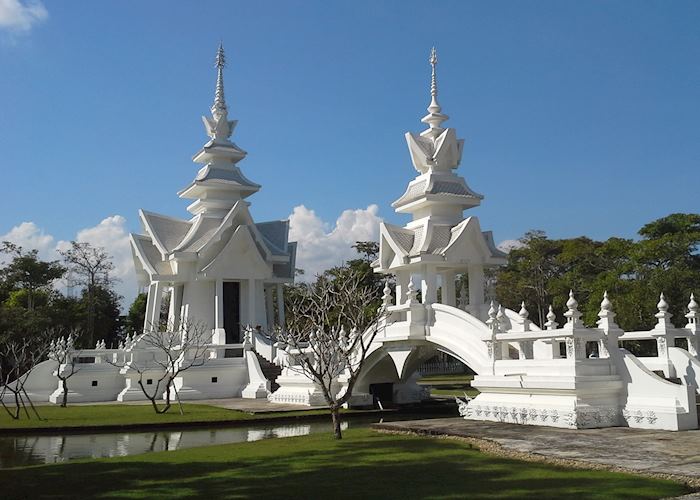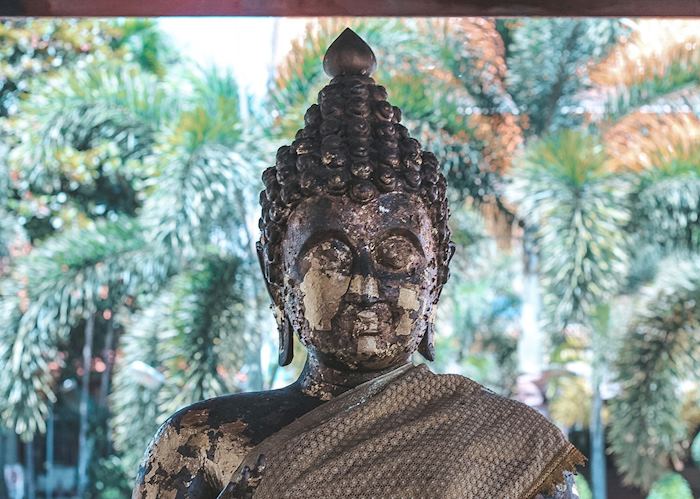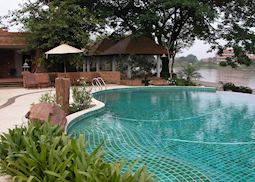Jump to:
Though it was once the royal capital of Thailand, today Chiang Rai is a sleepy, subdued city near the country’s northern border. Because it attracts fewer visitors than Chiang Mai, its sister city, Chiang Rai offers a chance to explore authentic local life as well as smaller markets and several temples, both historic and modern. It also acts as the gateway, if you want to explore the countryside and villages of the Golden Triangle.
Wat Phra Kaew is the most revered temple in the city, and one of the oldest. The precise date of the founding is unknown, but one of the wat’s pavilions was struck by lightning in 1434, revealing the Emerald Buddha. Thai people consider the fate of their country to be symbolically entwined with the fate of the hip-high jade statue, which is now on display in Bangkok.
Today, a close (but deliberately imprecise) replica resides in a splendiferous pavilion behind the sermon hall. Built in classic Lanna style, the red chapel is heavily encrusted with gold-painted geometric decorations.
Some 13 km (8 miles) south of the city, you’ll find Wat Rong Khun, which offers a totally different temple experience. A blindingly white complex of buildings, it glitters in the sunlight thanks to millions of tiny mirrors. It’s a contemporary temple-cum-art-installation, designed and built by artist Chalermchai Kositpipat. He considers the ongoing construction to be an offering to the Buddha.
The architecture here is laden with symbolism, from an eerie sea of grasping, disembodied hands as you enter the wat to a surreal interior mural that depicts flame-wreathed demons, George Bush and Hello Kitty. The monochromatic exterior paint scheme has only one exception — the gold-painted buildings that contain the restrooms.
Located just north of the city, Baan Dam can be translated as the Black Temple or Black House. It’s not a place of worship but the one-time home of another Thai artist. Chiang Rai native Thawan Duchanee was known for his spiritually infused paintings as well as the arrestingly eccentric architecture that’s on display at Baan Dam.
Throughout the buildings — many of which are stained an ominous black — you’ll find the artist’s collections of paintings, relics, animal skins and bones on display.
In the centrally located Municipal Market, you can visit the city’s night bazaar once the sun goes down. Tables are heavily laden with everything from DVDs and plastic Buddha statues to hand-loomed fabrics created by artisans from the hills.
If you’d like to try northern Thai cuisine, wander among the food stalls to peruse the many dishes on offer. You’ll see spicy Isaan sausages sizzling on the grill, polystyrene trays loaded high with green papaya salad, fish-shaped biscuits and platters of freshly fried insects. On Saturday nights, the municipal market transforms into the Walking Street Market, with even more vendors as well as musical performances and dancing, much of it traditional.
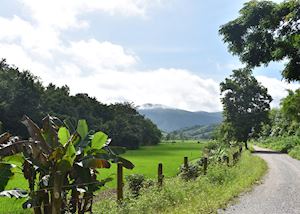 Outside the city, the landscape is densely covered in greenery, from rice terraces to jungles filled with broad-leafed trees. We can arrange short- or full-day treks through the countryside, exploring the rivers, mountains and hilltop villages.
Outside the city, the landscape is densely covered in greenery, from rice terraces to jungles filled with broad-leafed trees. We can arrange short- or full-day treks through the countryside, exploring the rivers, mountains and hilltop villages.
Chiang Rai is also a good base for exploring the Golden Triangle. Many of the hamlets closest to the city are essentially Potemkin villages, where locals dress up in traditional garb and perform for visitors. We can direct you away from these showpieces to authentic villages where you can learn more about the real daily lives of the various tribes that live in these hills, including the Akha in Doi Chang.
The Golden Triangle was once notorious for violence related to the production of opium, but the late King Rama IX created an initiative to encourage the local people to cultivate cash crops like coffee and tea, instead.
We can arrange for you to take a tour of one of these now-thriving villages and see its coffee-growing process and macadamia nut plant. If you’re fortunate, you might glimpse some of the older ladies, who still wear the heavily embroidered traditional dress.
Best time to visit Chiang Rai
Chiang Rai’s cool, dry season is between November and March, when the daytime temperatures don’t get much over 25°C (77°F).
You might find some haze in the air during February and March, due to the slash-and-burn agriculture in the countryside.
The hotter temperatures and monsoon rains begin in April and taper off throughout October. If you don’t object to rain showers, October can be a good time to visit the region — there are fewer people and the countryside is very green.
who's been there
-
01993 838 92501993 838 115
- Make an enquiry
Suggested itineraries featuring Chiang Rai
Our itineraries will give you suggestions for what is possible when you travel in Chiang Rai, and they showcase routes we know work particularly well. Treat them as inspiration, because your trip will be created uniquely by one of our specialists.
Places near Chiang Rai
- The Golden Triangle 37 miles away
- Fang 41 miles away
- Doi Angkhang 51 miles away
- Chiang Mai 95 miles away
- Pai 99 miles away
- Nan 100 miles away
- Mae Hong Son 129 miles away
- Sukhothai 201 miles away
- Loei Province 208 miles away
- Nong Khai 237 miles away
- Udon Thani 260 miles away
- Isaan 267 miles away
Photos of Chiang Rai
Accommodation choices for Chiang Rai
We’ve selected a range of accommodation options for when you visit Chiang Rai. Our choices usually come recommended for their character, facilities and service or location. Our specialists always aim to suggest properties that match your preferences.
-
![Mora Boutique restaurant]()
Mora Boutique
Chiang Rai -
![Le Méridien, Chiang Rai]()
Le Méridien
Chiang Rai -
![Legend Resort, Chiang Rai]()
The Legend Boutique River Resort & Spa
Chiang Rai

